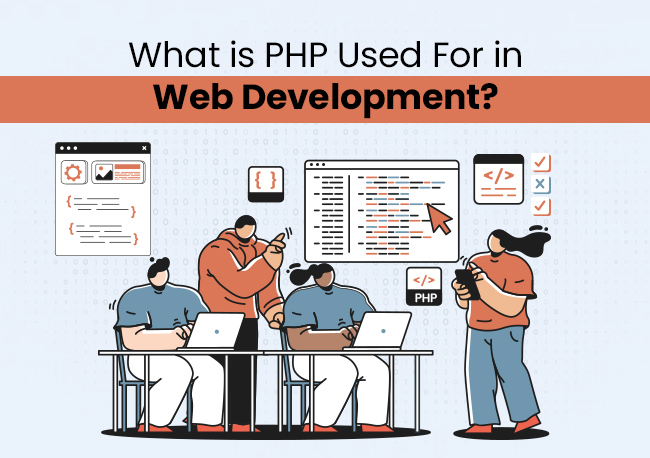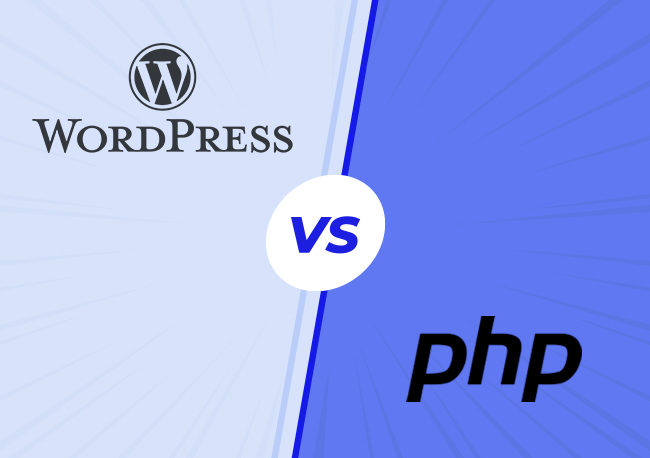| Getting your Trinity Audio player ready... |
PHP is one of the important coding languages in the dynamically competitive world of web development. It plays a pivotal role as a server-side scripting language to build an engaging and captivating website; PHP has always been a silent but impactful architect, shaping our digital initiatives.
This article is designed to take you through the important aspects of PHP, unveiling its significance and growth journey over time and spotlighting its indispensable role in web development.
Overview of PHP
PHP was initially introduced in the web development world as a “Personal Home Page” and has evolved into a “Hypertext Preprocessor.” Unlike replacing HTML, it works alongside it.
In the mid-1990s, Rasmus Lerdorf created PHP to keep track of people visiting his online resume. Back then, it was pretty basic. However, as time passed, PHP improved, and by 1998, PHP 3 was developed with improved features. Now, it has become a super popular scripting language for building websites.
Also Read: Which Technology Is Best For Website Development?
PHP as a Server-side Scripting Language
PHP stands out in web development because it operates behind the scenes on the server. When you interact with a PHP-based website, such as clicking a button, the server handles the code execution, performs necessary tasks, and displays the outcomes.
This ensures that users enjoy a customized and interactive experience without being exposed to the technical complexities in the background.
Also Read: Best YouTube Channels For Learning Web Development
➢ Popularity and Widespread Adoption
Many types of websites, from small blogs to large platforms, prefer using PHP due to its simplicity, flexibility, and widespread familiarity among developers. Its user-friendly nature, adaptability, and extensive developer community significantly contribute to PHP’s ongoing prominence within the continually growing field of web development.
Also Read: WordPress Vs PHP Websites – Difference To Know
Features and Capabilities of PHP
➢ Dynamic Content Generation
- PHP excels in generating dynamic content for websites. For example, PHP dynamically generates personalized content by incorporating user-specific data.
- This flexibility and ability to generate content based on variables make PHP well-suited for creating dynamic and interactive web pages.
- Enables the creation of web pages that adapt and respond to user input.
- Facilitates the display of personalized and relevant information based on varying conditions. For example, with PHP, a website can greet users differently based on the time of day, providing a personalized and relevant experience.
➢ Interactivity and User Engagement
- It empowers the creation of vibrant and captivating websites that actively engage users, enhancing the overall interactive experience.
- Helps build things like forms, surveys, and ways for users to give feedback.
- Makes the user’s experience better by allowing them to interact with web applications easily.
➢ Database Connectivity
- Offers seamless integration with databases, including popular choices like MySQL.
- Lets you store, find, and work with data effectively.
- Makes it possible to create systems for managing content, online shopping platforms, and applications that use databases.
➢ Integration with Other Technologies
- Exhibits flexibility by easily integrating with various technologies.
- Supports integration with JavaScript for client-side interactivity.
- Facilitates communication with external APIs, expanding the functionality of web applications.
➢ Scalability and Performance
- Inherently scalable, catering to a broad spectrum of project sizes.
- Modular architecture allows developers to scale applications as needed.
- Shows strong performance, making sure web applications run quickly and efficiently.
Also Read: Website Optimization Tips To Increase Website Performance
How PHP Works in Web Development?
PHP works as a valuable server-side scripting language in web development. It plays an important role in processing and executing tasks on the server before delivering the final output to users. The typical workflow involves the following steps:
1. Client Request
- A user initiates a request by accessing a PHP-based web page through a browser.
- The request is sent to the web server hosting the PHP files.
2. Server-Side Processing
- PHP code embedded in the requested web page is executed on the server.
- This server-side processing generates dynamic content, interacts with databases, and performs various computations.
3. Output to Browser
- After processing, the content, often HTML, is sent back to your web browser.
- Your browser then understands and shows you the result.
4. Dynamic Interaction
- PHP enables dynamic interactions by allowing users to submit forms, input data, or trigger events.
- The server processes these interactions, updating content dynamically without requiring a full page reload.
Also Read: Is Web Development Dying In Future?
Common Use Cases of PHP
PHP finds extensive application across various domains, showcasing its adaptability and versatility. Some common use cases include:
➢ Content Management Systems (CMS)
- PHP is compatible with popular Content Management System (CMS) platforms like WordPress, Joomla, and Drupal.
- It makes creating, changing, and handling digital content on websites easier.
- Dynamic content generation and user-friendly interfaces are key aspects of a PHP-driven CMS.
Also Read: Best Content Management System Platform Optimized For SEO
➢ eCommerce Websites
- PHP fuels many eCommerce CMS platforms like Magento, WooCommerce, and OpenCart.
- It guarantees a secure and efficient online shopping experience by managing tasks such as order processing and inventory management.
- The integration with databases ensures that product information is stored and retrieved seamlessly.
Also Read: A Useful Guide To Building An eCommerce Website From Scratch
➢ Social Networking Platforms
- PHP is pivotal in developing social networking sites, with Facebook being a prominent example.
- It supports real-time user authentication, profile management, and dynamic content updates.
- PHP’s ability to handle large user databases contributes to the scalability of social platforms.
➢ Web Applications and Portals
- PHP is used to build various web applications, from straightforward tools to intricate business software.
- Thanks to its ability to connect with databases and external services, PHP is ideal for crafting web portals with advanced features and functionalities.
Also Read: Will AI Replace Web Developers – Know The Truth
Advantages of Using PHP in Web Development
The below-listed advantages depict the reasons why PHP gained immense popularity in web development:
➢ Open Source
- PHP is open-source, which means it’s free to use and share with others.
- This helps reduce development costs and allows a vast community of developers to contribute to its improvement.
➢ Wide Adoption and Community Support
- PHP is widely used and has a big community of developers who are actively involved.
- This community support ensures that PHP gets regular updates, fixes for security issues, and plenty of online help for problem-solving.
➢ Versatility
- PHP is versatile and supports various platforms, making it compatible with operating systems.
- It can seamlessly integrate with other technologies, offering flexibility in web development.
➢ Rapid Development
- PHP simplifies and accelerates the development process with its straightforward syntax and vast libraries.
- Developers can quickly build prototypes and iterate over projects efficiently.
Also Read: What Makes A Good Website Checklist? A Complete Guide
➢ Database Support
- PHP works well with various databases like MySQL, PostgreSQL, and SQLite.
- This feature simplifies linking with databases, enabling websites to be dynamic and focused on handling data.
➢ Scalability
- PHP applications can easily adapt to different project sizes, making them a good fit for projects of all kinds.
- It can efficiently handle increased workloads and traffic as websites grow.
➢ Security
- PHP strongly focuses on security, and when used correctly, it can create secure web applications.
- The community actively addresses security vulnerabilities and provides guidelines for secure coding practices.
Also Read: Best Practices To Secure Your Website
Challenges and Limitations of PHP
While PHP offers numerous advantages, it is essential to consider potential challenges and limitations:
➢ Inconsistent Standard Library
- The standard library in PHP can be inconsistent, leading to variations in function names and parameter orders.
- This inconsistency may pose challenges for developers when switching between different functions.
➢ Less Strict Typing
- PHP is loosely typed, allowing variables to change types dynamically.
- While flexibility can be helpful, it might cause unexpected issues and mistakes if not handled cautiously.
➢ Performance Concerns
- Compared to some other languages, PHP may face performance concerns, especially in highly complex and resource-intensive applications.
- Caching mechanisms and optimization practices can address these concerns to a certain extent.
➢ Limited Multithreading
- PHP traditionally has limited support for multithreading, which can impact its performance in certain scenarios.
- This limitation might affect the scalability of PHP applications in specific use cases.
➢ Security Risks with Poor Coding Practices
- Security issues could exist if developers don’t use good practices and secure coding habits.
- It’s important to know about potential risks and follow recommended security practices.
Also Read: How Can You Make A Website Look More Professional?
Best Practices and Tips for PHP Development
To ensure efficient and secure PHP development, consider the following best practices and tips:
➢ Use Frameworks and Libraries
- Use existing PHP frameworks and libraries to simplify development and capitalize on their pre-built functionalities.
➢ Adopt Object-Oriented Programming (OOP)
- Adopt Object-Oriented Programming (OOP) principles to structure your code to enhance organization, promote code reuse, and simplify maintenance.
➢ Implement Input Validation and Sanitization
- Check and clean up users’ information to avoid potential security issues, such as protecting against harmful code injections or attacks that manipulate your website’s content.
➢ Secure Database Interactions
- Use parameterized queries or prepared statements to secure database interactions and prevent SQL injection.
➢ Regularly Update PHP Versions
- Keep PHP versions updated to benefit from security patches, performance improvements, and new features.
➢ Optimize Code and Use Caching
- Optimize PHP code for better performance and implement caching mechanisms to reduce server load.
Also Read: How To Fix A Slow Website?
➢ Follow a Coding Standard
- For improved code readability and collaboration, adhere to a consistent coding standard, such as PSR (PHP Standards Recommendations).
➢ Enable Error Reporting in Development
- Enable error reporting during the development phase to identify and fix issues promptly.
➢ Implement HTTPS
- Implement HTTPS to secure the information exchanged between the user’s device and the server, adding an additional layer of protection for the transferred data.
➢ Regularly Back Up Data
- Regularly back up your data to avoid losing important information in unexpected situations or security issues.
Also Read: Top 5 Reasons Business Owners Need Website Backup
Future Trends and Developments in PHP
PHP continues to evolve, and several trends and developments shape its future in web development:
➢ PHP 8 and Beyond
- The most recent release, PHP 8, introduced various enhancements and tools, including the Just-In-Time (JIT) compiler. This addition is designed to optimize performance, resulting in faster and smoother execution of processes.
- Ongoing updates and future PHP versions are expected to optimize speed and capabilities further.
➢ Increased Use of PHP in Microservices
- PHP is now being used more in building flexible and scalable applications, especially in smaller, manageable parts known as microservices.
- This shift is fueled by combining PHP with lightweight frameworks and container technologies that help manage these smaller parts effectively.
➢ Emphasis on Security
- Keeping PHP applications safe and secure will continue to be a priority, with continuous efforts to fix vulnerabilities and improve secure coding practices.
- Following established secure coding standards and frameworks will be key to strengthening the security of PHP applications.
➢ Greater Adoption of PHP Frameworks
- Frameworks like Laravel, Symfony, and CodeIgniter will continue to grow in popularity.
- These frameworks provide organized development with handy built-in features and make developers more productive.
➢ Integration with Cloud Services
- PHP applications will likely see increased integration with cloud services and serverless computing platforms.
- More developers in the PHP community will start using cloud-native development approaches.
➢ Enhancements in Developer Tooling
- PHP developers can expect better experiences with improved tools like development environments, debugging aids, and code analysis utilities.
- Easier workflows and more automation are on the horizon for developers using PHP.
Also Read: 5 Best Website CMS Detector Tools You Must Try
Conclusion
In conclusion, PHP is a powerful and flexible server-side scripting language with consistent adaptability and growth. Initially, it was designed as simply a basic tool for personal websites, but it has evolved to effectively drive success for some of the world’s largest websites. This demonstrates its ability to adapt and improve over the years.
As PHP gets updated with new versions, improving and faster, it stays a go-to language for developers who want something powerful but easy to use when building websites.3
FAQs
PHP acts as a behind-the-scenes scripting language on the server in web development. It handles code processing on the server side, creating dynamic content that gets sent to your web browser for you to see and interact with.
PHP finds widespread use in web development, helping to craft dynamic websites, manage content systems, run e-commerce platforms, and build various web applications. Its adaptability and ability to work seamlessly with different databases contribute to its popularity.
PHP is mainly employed for back-end development tasks. It manages server-side operations, connects with databases, and generates dynamic content. Developers typically use HTML, CSS, and JavaScript to handle front-end tasks.
Several prominent websites and platforms extensively use PHP, including Facebook, Wikipedia, WordPress, Mailchimp, Yahoo!, Canva, and Slack. These examples highlight PHP’s scalability and suitability for diverse applications.
Yes, PHP remains relevant in modern web development practices due to its regular updates, robust community support, and adaptability. The recent release of PHP 8 and ongoing enhancements further solidify its importance in building scalable, dynamic, and interactive web applications.




